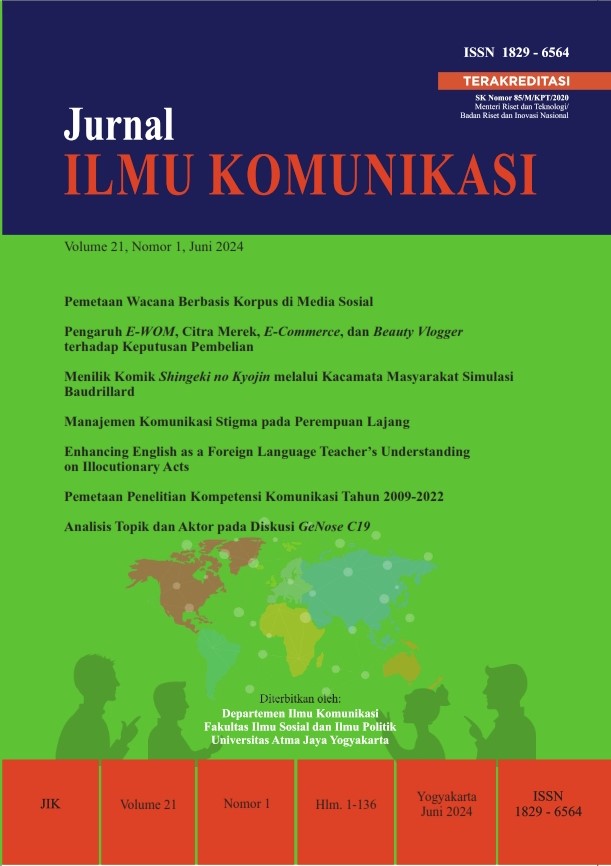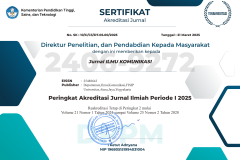Pemetaan Wacana Berbasis Korpus di Media Sosial
DOI:
https://doi.org/10.24002/jik.v21i1.6452Keywords:
#MeToo, counterpublic, Indonesia, the fifth estate, TwitterAbstract
The #MeToo hashtag grew into digital activism among the Twitter users. This activity was becoming the networking space which increased the communication power and collaboration. This research using counter public and the fifth estate as a frame for thinking with a method of social media analyses and critical discourse based on corpus. The object of this research is 631,897 tweets of #MeToo from October 15, 2017 until March 31, 2020. The result shows there is no counter public through this hashtag for the Indonesian context. Nevertheless, users applied the social control for legitimacy of laws and sexual abuse legal cases.
References
Ancarno, C. (2020). Corpus-assisted discourse studies. In Anna De Fina & Alexandra Georgakopoulou, The Cambridge handbook of discourse studies, pp. 165 – 185. Cambridge, UK: Cambridge University Press.
Ali, F. U. (2021, March 16). #MeToo-Awal Mula. Asiawomennews.com. <https://www.asiawomennews.com/women-opinion/metoo-awal-mula/>
Baker, P. (2010). Sociolinguistics and corpus linguistics. Edinburgh, Skotlandia: Edinburgh University Press.
Bennett, W. L., & Segerberg, A. (2013a). The logic of connective action: Digital media and the personalization of contentious politics. New York, NY: Cambridge University Press.
--------------------------------------. (2013b). The logic of connective action: Digital media and the personalization of contentious politics. New York, NY: Cambridge University Press.
Bethel, C. (2018). #MeToo: The perfect storm needed to change. Harvard Public Health Review, 16, 1–5.
Bernardini, V. (2021). Collective voices online: Discursive activism in #MeToo. In Information Resources Management Association, p. 724-279. Pennsylvania, Amerika: IGI Global.
Brouwer, D. C. (2006). Communication as counterpublic. In G.J. Shepherd, J. St. John, & T. Striphas (Eds.), Communication as….: Perspectives on theory, h. 195-208, Thousand Oaks, CA: Sage.
Cooper, S. D. (2006). Watching the watchdog: Bloggers as the fifth estate. In Stephen D Cooper, Watching the watchdog: Bloggers as the fifth estate, p. 277-303. Spokane, AS: Marquette Books.
Deem, R. (2002). Talking to manager-academics: Methodological dilemmas and feminist research strategies. Sociology, 36(4), 835–855.
Dow, B. J. (1992). Performance of feminine discourse in designing women. Text and Performance Quarterly, 12(2), 125–145.
Dutton, W. H. (2009). The fifth estate emerging through the network of networks. Prometheus, 27(1), 1–15.
Foot, K. A., & Schneider, S. M. (2002). Online action in campaign 2000: An exploratory analysis of the US political web sphere. Journal of Broadcasting & Electronic Media, 46(2), 222–244.
Fraser, N. (1990). Rethinking the public sphere: A contribution to the critique of actually existing democracy rethinking the public sphere. Social Text, 26(25), 56-80.
Goodin, R. E., & Tilly, C. (2006). The Oxford handbook of contextual political analysis (Vol. 5). Oxford, UK: Oxford University Press.
Greene, R. W. (2002). Rhetorical pedagogy as a postal system: Circulating subjects through Michael Warner’s publics and counterpublics. Quarterly Journal of Speech, 88(4), 434–443.
Habermas, J. (1991). The structural transformation of the public sphere: An inquiry into a category of bourgeois society. Massachusetts, AS: MIT press.
Hansen, M. (1993). Unstable mixtures, dilated spheres: Negt and Kluge’s the public sphere and experience, twenty years later. Public Culture, 5(2), 179–212.
Dataverse, H. (2020, March 31). #metoo Digital Media Collection - Twitter Dataset. Dataverse.harvard.edu. <https://dataverse.harvard.edu/dataset.xhtml?persistentId=doi:10.7910/DVN/2SRSKJ>
Enderle, T. (2018). A rhetorical analysis of the public sphere through the# MeToo movement. Quest: A Journal of Undergraduate Student Research, 6(1), 52-68.
Hamel, P., Lustiger-Thaler, H., Mayer, M. (2000). Urban movements in a globalising world. London, UK: Routledge.
Hidayat, A., & Setyanto, Y. (2020). Fenomena catcalling sebagai bentuk pelecehan seksual secara verbal terhadap perempuan di Jakarta. Koneksi, 3(2), 485–492.
Margolis, M., & Resnick, D. (2000). Politics as usual (Vol. 6). Thousand Oaks, CA: Sage Publications.
Martini, F. (2020). Countering the counterpublic? The German #metoo network ontwitter. Paper presented in
the 21stAnnual Conference of the Association of Internet ResearchersVirtual Event, 27-31 October 2020. < https://spir.aoir.org/ojs/index.php/spir/article/view/11274/9949>
McCarthy, J. D., & Zald, M. N. (1977). Resource mobilization and social movements: A partial theory. American Journal of Sociology, 82(6), 1212–1241.
McDorman, T. F. (2001). Crafting a virtual counterpublic. Counterpublics and the State, 187–209.
Moyo, L. (2011). Blogging down a dictatorship: Human rights, citizen journalists and the right to communicate in Zimbabwe. Journalism, 12(6), 745–760.
Komnas Perempuan. (2019). National Commission on Violence against Women (Komnas Perempuan) National Human Rights Institution Independent Report on 25 Years of Implementing the Beijing Platform for Action (BPfA+25) in Indonesia. Jakarta, Indonesia: Komnas Perempuan.
Pain, P. (2021). It took me quite a long time to develop a voice: Examining feminist digital activism in the Indian# MeToo movement. New Media & Society, 23(11), 3139–3155.
Parahita, G. D. (2019). The rise of Indonesian feminist activism on social media. Jurnal Komunikasi Ikatan Sarjana Komunikasi Indonesia, 4(2), 104–115.
Park, A. (2017). MeToo reaches 85 countries with 1.7 M tweets. Cbsnews.com. <https://www.cbsnews.com/news/metoo-reaches-85-countries-with-1-7-million-tweets/>
Pegu, S. (2019). MeToo in India: Building revolutions from solidarities. Decision, 46(2), 151–168.
Pezzullo, P. C. (2003). Resisting national breast cancer awareness month: The rhetoric of counterpublics and their cultural performances. Quarterly Journal of Speech, 89(4), 345–365.
Randall, M. (2010). Sexual assault law, credibility, and ideal victims: Consent, resistance, and victim blaming. Canadian Journal of Women and the Law, 22(2), 397–433.
Sandhu, A., & Sandhu, A. (2007). The counter-public sphere. Intellectuals and the People, 63-78.
Sayej, N. (2017). Alyssa Milano on the# MeToo movement: We’re not going to stand for it any more’. Theguardian.com. <https://www.theguardian.com/culture/2017/dec/01/alyssa-milano-mee-too-sexual-harassment-abuse>
Schradie, J. (2018). The digital activism gap: How class and costs shape online collective action. Social Problems, 65(1), 51–74.
Selander, L., & Jarvenpaa, S. L. (2016). Digital action repertoires and transforming a social movement organization. MIS Quarterly, 40(2), 331–352.
Spinuzzi, C., Bodrožić, Z., Scaratti, G., & Ivaldi, S. (2019). Coworking is about community: But what is community in coworking? Journal of Business and Technical Communication, 33(2), 112–140.
Press, A. (2018, January 18). Robert redort on #MeToo movement: The role for men right now is to listen.Usatoday.com. <https://www.usatoday.com/story/life/movies/2018/01/18/robert-redford-sundance-film-festival-metoo-movement/1046196001/>
Vasconcellos, M., & Vasconcellos, A. M. (2012). Social movement, public policy changes and partnerships building for local development. INTERAÇÕES, 13(2), 243-258.
Victor, D. (2018). The #MeToo moment: I’m a straight man. Now what? The New York Times, 27.
Winarnita, M. (2020, January 26). Gerakan #MeToo Indonesia. Insideindonesia.org. <https://www.insideindonesia.org/gerakan-metoo-indonesia>
Young, A. G. (2018). Using ICT for social good: Cultural identity restoration through emancipatory pedagogy. Information Systems Journal, 28(2), 340–358.
Zald, M. N., & Ash, R. (1966). Social movement organizations: Growth, decay and change. Social Forces, 44(3), 327–341.
Downloads
Published
How to Cite
Issue
Section
License

This work is licensed under a Creative Commons Attribution 4.0 International License.
Jurnal ILMU KOMUNIKASI is an academic journal. As such, it is dedicated to the open exchange of information. For this reason, JIK is freely available to individuals and institutions. Authors who publish in Jurnal ILMU KOMUNIKASI will release their articles under the Creative Commons Attribution (BY) License. This license allows anyone to copy and redistribute the article in any medium or format as well as remix, transform, and build upon the material for any purpose, even commercially as long as they credit the authors for the original creation. For details of the rights authors grants users of their work, see the "human-readable summary" of the license, with a link to the full license. (Note that "you" refers to a user, not an author, in the summary)
 This work is licensed under a Creative Commons Attribution 4.0 International License.
This work is licensed under a Creative Commons Attribution 4.0 International License.














